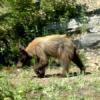Good points Norseman. Preservation of bones is not easy. We have high latitude permafrost
preservation of fauna bone collections of Glacial Lake Outburst Floods in Alaska, high latitude,
high altitude mummy finds in the Andes, and intermediate the high latitudes we have peat bogs,
tar pits, arid climates ( rift valley Africa ) and arid areas of Australia in the way of finding Mungo
Man and Mungo Woman.
Scavengers eat and scatter the kills of other predators. The African Savanna has been in front of
cameras for a long time. Predators rarely get to eat their kills. Scavengers swarm and take over
the carrion and scatter it. The African Leopards / Black Panthers are an exception to the
'smorgasbord' ground level frenzy. They drag various sized prey up into trees for undisturbed
days of meals.
My point is, out in the open, bones are widely scattered and animals that need bone marrow and
calcium will eat the bones but leave the teeth*. Simple, basic separation, excluding soil acidity
leaves us with 'open ground' and caves. Scavengers drag carrion parts into caves attempting to
have a secluded area for meals. An interesting fact about Gigantopithecus blacki is that the only
known mandibles and teeth are 'cave finds'. It is believed that porcupines ate the bones for the
calcium and not the teeth. I would guess that the old world porcupines in that area had wicked
quills. I am not of the belief that Giganto traveled out of Asia.
Wiley Online Library has a free article on Giganto. It is a good read.
https://onlinelibrary.wiley.com/doi/10.1002/ajpa.23150
Keep in mind that when you are on Safari in Africa and a skeleton falls out of a tree, jump back
into the Land Rover and punch it.
For the rest of us, never go into caves (bats, bat guano).
* footnote. I believe that Alligator snapping turtles eat everything including teeth. An area lacking predators of any size will have weathered skeletons that have been picked clean by birds and microbes. I have only seen one example in the way of a dog skeleton.


